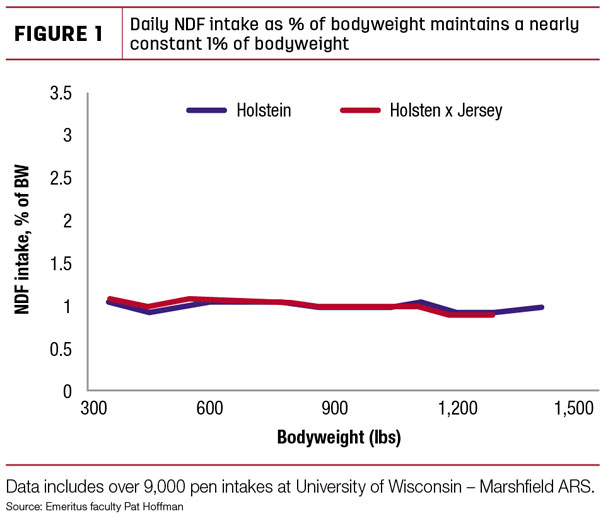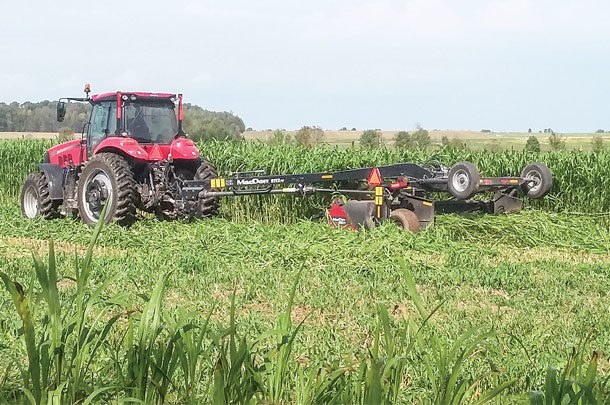High-quality corn silage and alfalfa is often used for feeding dairy heifers. These can work well for young heifers up to about 8 to 12 months of age depending on forage quality.
However, pregnant dairy heifers have lower energy needs than younger dairy heifers, and feeding the correct diet energy is important to control weight gain. Pregnant heifers require approximately 58% to 62% total digestible nutrients (TDN) depending on environment (housing, activity, climate), while corn silage and alfalfa silage are usually well above this level.
Research at the University of Wisconsin Marshfield Agricultural Research Station with feeding corn silage and/or alfalfa silage diets (65% TDN) to pregnant heifers showed gains can be 2.5 pounds per day or greater. Recommended gains for dairy heifers are 1.8 to 2.2 pounds per day, with higher gains leading to greater fat deposits and potentially more difficult transition to lactation.
Delaying harvest to attain more mature alfalfa or grasses will reduce energy content; however, often the main goal of dairy forage production is usually to produce high-quality forages for lactating cows.
Use of higher-fiber forages such as warm-season perennials, straw, corn stover, sorghums or cereal grain forages at heading can be used to dilute diet energy and restrict intakes when combined with corn silage and alfalfa silage. Higher-fiber diets help to control intake since dairy heifers eat approximately 1% of bodyweight as neutral detergent fiber (NDF) each day (Figure 1) in addition to the lower energy content.

A 1,200-pound heifer will eat approximately 12 pounds NDF, and if the diet contains 45% NDF, the heifer will eat about 27 pounds dry matter (DM); however, at 50% NDF, the heifer will eat about 24 pounds dry matter.
Warm-season grass
Recent work at the Marshfield research station looked at the growth and management of eastern gamagrass, a warm-season perennial grass. Based on multiple years of data, the greatest forage yield was from a single harvest in mid-September. Dry matter content at a mid-September cutting was 30% to 40%, so minimal to no wilting is needed prior to harvest. Yields were 3 to 4 tons DM per acre with an NDF content of about 75% and crude protein 5% to 7% DM when harvested in September.
In a heifer feeding study, feeding eastern gamagrass at 20% to 30% of the diet helped control intakes and gains within recommended guidelines. A unique feature of gamagrass is its high palatability, so heifers readily consume the silage with minimal or no sorting that may occur when using straw.
Roughage sources such as straw and corn stover can also be used in heifer diets. Depending on roughage quality (NDF, energy, digestibility) inclusion rate is usually 10% to 20% of diet DM. Sampling of the roughage is needed as variation exists in fiber content, digestibility and mineral content.
These have been used successfully in recent studies to control intakes and gains; however, heifers can sort these roughages, especially for corn stover. Pre-chopping to a 2-inch length and/or adding water for a target diet DM of 45% to 50% may help minimize sorting. Also, feeding for minimal refusals (few feed particles remaining in the bunk) will ensure heifers eat the desired diet and not sort for the higher-quality forages.
Cereal grain forages
Cereal grain forages (rye, triticale, wheat, barley) are options that more producers may have potential to use with the increased production of winter cover crops. Harvesting at boot stage will produce higher-quality forage that can be fed to lactating cows or pre-breeding heifers, while at heading stage will be more ideal for pregnant heifers. When harvested between boot and heading, protein and energy can be close to ideal to feed the forage alone or with minimal other forages. Yields have been 1 to 2 tons DM per acre at these stages (harvested mid- to late May) with potential for double cropping thereafter.
Sorghums
Sorghums (forage sorghum, sorghum-sudangrass, sudangrass) are another lower-energy option in heifer diets that can have similar forage yields to corn silage. Conventional (non-BMR) and photoperiod-sensitive sorghums have an ideal fiber and energy content to blend in pregnant heifer diets with a moderate to high-quality haylage or possibly a protein byproduct (e.g., distillers grain, gluten feed) when forage supplies are low.
Harvesting strategy affects yield with a single harvest having one-and-a-half to two times greater yield than a two-cut system. In plot studies done over two years, yields for conventional forage sorghum and sorghum-sudangrass planted in early to mid-June in 15-inch rows and harvested one time in October or early November were 6 to 8 tons DM per acre. NDF content was 55% to 60% and protein was 5% to 7%.
Moisture content can be a problem using a single fall harvest when planted later in summer (after mid-June) with cutting and wilting likely needed earlier in fall to ensure a crop is harvested. This situation occurred in a recent trial with sorghum-sudangrass in a 12-acre production field at Marshfield ARS (planted July 4, 2017) that yielded 2.3 tons DM per acre when harvested in mid-September.
In a feeding study with this forage, we compared the use of a diet diluted with low-quality grass hay at 25% of the diet to the inclusion of sorghum-sudangrass at 50% of the diet in order to reduce the energy and increase NDF content. Energy content of the diets were similar (60% to 61%), but the NDF content of the diets were key in controlling intakes with the sorghum-sudangrass diet having 55% NDF, while the diet diluted with grass hay had 48% NDF. This led to lower intakes by heifers fed the sorghum-sudangrass diet and more optimal gains (1.9 to 2 pounds per day) compared to heifers fed the diet diluted with grass hay (2.4 pounds per day).
Viable options exist
Producers have several forage options to blend with corn silage and haylage to help control intakes and growth of dairy heifers. The choice will depend on cropping and rotation systems for each operation. It is suggested to discuss options with your agronomist and nutritionist about best field management practices, how it will affect other forage inventories and diet formulation.










